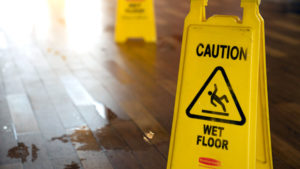

Pay attention to wet floor protocols to keep your premises safe.
When unexpected spills, tracked-in snow or rain, leaking appliances or other sources lead to floor contamination, your employees’ response can easily be the difference between a slip and fall, prompting a potential injury claim, or it being a non-event.
WET FLOOR PROTOCOL
To handle unexpected contamination of your floors, train your employees about wet floor protocol and enforce it.
- Have supplies – wet floor signs, sweeping compound, mops and buckets, rolls of paper towels, broom and dustpan – staged at strategic locations so they can be retrieved quickly. At a minimum, wet floor signs should be available at various locations throughout the business.
- Once a spill or other contaminant is detected, go to it immediately and warn others away from the area. Then, set out wet floor signs as quickly as possible.
- Make sure the source of the contamination is contained so the situation does not get worse.
- If additional supplies are needed to clean up the spill, have an employee stand guard to continue to warn people away while another employee retrieves supplies.
- If a co-worker is not available to stand guard over a spill, mark the spill with something before leaving the area to retrieve cleaning supplies. In a restaurant, this might be placing an empty chair over the spill temporarily; in a grocery store, pull down some items from the shelf and block access to the spill. This will be more visible than the liquid covering the floor. This technique should not be left in place for longer than the time it takes to quickly obtain the cleaning supplies and return to the scene.
- Clean up the contamination.
- Keep warning signs in place until the area has been cleaned and has had time to dry.
WINTER WEATHER CONSIDERATIONS
If snow and ice are concerns in your location, you already know that these conditions can wreak havoc on your employees’ and customers’ ability to safely get in and out of your business. Assign someone to monitor weather forecasts, maintain adequate supplies of shovels and salt and coordinate snow plowing, shoveling, and salt and sand application with either internal personnel or hired snow and ice removal contractors.
Be prepared to promptly clean up snow and water tracked into your building.
Accidents are, by definition, unexpected. How we react to them should not be.
This loss control information is advisory only. The author assumes no responsibility for management or control of loss control activities. Not all exposures are identified in this article. Contact your local, independent agent for insurance coverage advice and loss control information.
